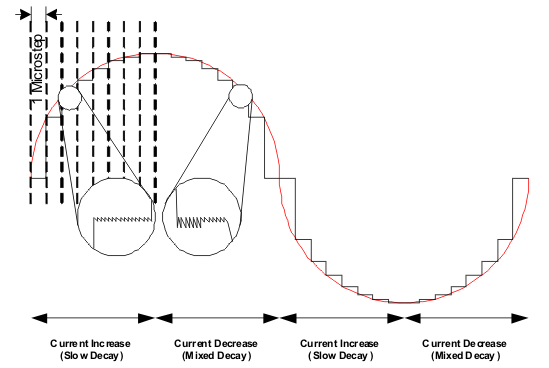SLVA321A August 2011 – April 2021 DRV8811 , DRV8818 , DRV8821 , DRV8823 , DRV8823-Q1
2.3 Mixed Decay
During a mixed decay recirculation mode, current is made to decay towards zero faster than on slow decay method but slower than the fast decay method. This technique is achieved by coordinating FET switch ON and OFF time so that fast decay mode is engaged for a fixed amount of time, subsequently engaging in slow decay mode for the remaining period of time. The ratio of how long the system will be maintained in fast decay versus slow decay is referred to as the mixed decay percentage.
Mixed decay is particularly meaningful to stepper motor driving, but most importantly, to microstep driving. When microstepping, a certain wave shape is to be maintained in order to obtain the best motion quality. For example, it is common to drive the stepper motor windings with a sine wave like current profile. Triangle shapes and rhomboid shapes can also be used to the same extent.
The faster the stepper motor is commanded to move, the harder it is to follow the desired wave shape. This is due to the fact that the motor inductance limits how fast the windings are bled out. Therefore, it is necessary to find a rate of current recirculation in between fast and slow decay modes to accommodate the different portions of the wave shape in question.
When current is increasing, as the microsteps are issued, preferred recirculation mode is slow decay. In essence, slow decay mode is ideal due to decreased EMI and increased efficiency during recirculation. During the increase of current stage on the superimposed waveform (first 90 electrical degrees), slow decay is enough to handle changes in current value as new microsteps are issued as shown in Figure 2-5.
 Figure 2-5 Mixed Decay Mode
Figure 2-5 Mixed Decay ModeHowever, slow decay mode is not fast enough to bleed out the current on the inductor with the speed necessary to jump to the next microstep and still follow the wave shape when the current is decreasing. Fast decay would be too fast and would also account for warped wave shape. A safe point is found by selecting a reasonable mixed decay ratio.